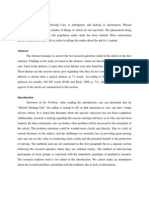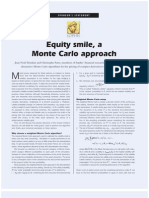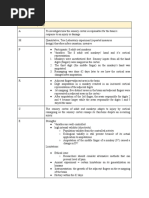Journal Article Critique Nursing 665
Journal Article Critique Nursing 665
Uploaded by
api-214213767Copyright:
Available Formats
Journal Article Critique Nursing 665
Journal Article Critique Nursing 665
Uploaded by
api-214213767Original Title
Copyright
Available Formats
Share this document
Did you find this document useful?
Is this content inappropriate?
Copyright:
Available Formats
Journal Article Critique Nursing 665
Journal Article Critique Nursing 665
Uploaded by
api-214213767Copyright:
Available Formats
Journal Article Critique Nursing 665 Elizabeth Smith Hollis Misiewicz
Meade, C. M., Bursell, A. L. & Ketelsen, L. (2006). Effects of nursing rounds on patients call light use, satisfaction, and safety. American Journal of Nursing, 106 (9), 58-70.
Overview The article Effects of Nursing Rounds on Patients Call Light Use, Satisfaction, and Safety describes a quasi-experimental nonequivalent group design research study that attempted to determine if nursing rounds conducted on a regular schedule would reduce patient call light use, increase patient satisfaction and improve patient safety as determined by a decrease in falls. The sample was drawn from a nonrandomized sample of hospitals from fourteen states, urban and rural and ranging in size from 25 to 600 beds. Staff was trained in rounding protocols and data was obtained over a six week period, two weeks prior to rounding and four weeks after the rounding protocol was established. This research study exhibited both strengths and weaknesses which will be described in this paper. Strengths The literature search conducted by the researchers was organized and succinct. It identified a gap in the research for the need to quantify whether the initiation of patient comfort rounds would result in increased patient satisfaction, decreased call light use and improve patient safety. The hypothesis was complex and unidirectional clearly stating that nursing rounds on a regular basis would; (1) reduce call light use; (2) increase patient satisfaction and (3) improve patient safety as measured by falls. The sample was stratified to similar types of units between the two experimental groups and the control group to increase internal validity. All participating hospitals were required to have at least one unit in the experimental group and one unit as a comparison group also increasing internal validity. This sample was drawn from a variety of hospital types in various settings that could conceivably increase
the generalizability of the findings to a larger population. The design of the study was clearly explained so replication would be possible. The rounding protocol was clearly stated in specific steps so the independent variable of nursing rounding would be the same within the experimental groups. All members of the experimental groups went to training sessions conducted by the principal investigator. Nurses from the comparison group were not exposed to any training session so they would not inadvertently perform the same actions as the experimental group. This would all relate to increasing internal validity. Compliance with the protocol was verified by nurse managers on a daily basis and the principal investigator on a weekly basis. The four week duration of rounding was determined based on cognitive-behavioral and learning literature which suggests that the more complex the task, the longer it takes to fully integrate it into behavior. The researchers divided the rounding period into two week segments to better analyze the strength of the learning curve. The operational definition of patient safety as a measurement of the frequency of patient falls was clearly stated and easily quantifiable. The researchers did obtain IRB approval at all of the hospitals who participated in the study. Weaknesses The non-random sampling and assignment to groups has an inherently high risk for bias, and the proof of this seems to be clear in the results. Chief nursing officers and nurse managers chose which units would participate in the study and whether they would be in the one-hour rounding group or the two-hour rounding group. The patient satisfaction scores were lower for units that were assigned the two-hour rounding before and after the intervention was applied. Also, units were chosen specifically for the strength of the nurse manager. This selection bias is a threat to internal validity. The results are affected by the very reasons for being chosen for the sample and for being assigned to a certain group. External validity is in question as well, related to how the results from these hand picked units might be generalizable to the larger target population.
Implementation of the treatment (rounding) was unreliable due to possible variations across the personnel implementing the rounds. While all members of the nursing staff were utilized and trained, there can be no doubt that there would be a difference in how rounding was accomplished between RNs, CNAs, LPNs, patient care assistants, and PCTs. Units came up with their own plan for how to rotate the rounding responsibilities. An example of variation is that some personnel would be able to give medications and some would not, causing inconsistency in the resolution of a medication need. Unreliable implementation of the treatment, or lack of treatment fidelity, varying between the personnel and the units, is a threat to statistical conclusion validity. Study results are also affected by data collection techniques. The researchers themselves recognized and discarded data from 41% of the units studied due to poor reliability and validity of data collection. Units did not share a consistent means of collecting call light data which created a lack of reliability. Unnecessary data regarding the reason for call light use was collected that did not have a bearing on the hypothesis. The instruments used for collecting data regarding patient satisfaction were various surveys created by different commercial vendors contracted by the hospitals. Raw scores were not provided to the researchers. The researchers attempted to stitch together mean data from different instruments, reflecting a low level of reliability and questionable content and construct validity in measuring patient satisfaction. This lack of precision in data collection is another threat to statistical conclusion validity. Suggestions for improving scientific vigor and generalizability This study could be improved by the use of a theoretical or conceptual framework to organize and direct the research. A conceptual framework would help the researcher develop a clearer conceptual and operational definition of the variables i.e. improved patient care management and its relationship to call bell use, patient satisfaction and falls. A conceptual model that could apply is Roys Adaptation Model. The nursing goal of promoting client adaptation by regulating internal and external
stimuli fits well with the concept of patient care management. Construct validity is improved when nursing theory provides a framework to link the hypothesis to the intervention and the instrument. In sampling design, a power analysis would help estimate sample size needs. To improve sample representativeness, bias needs to be minimized. A way to minimize bias would be to add randomization to the sampling process. A cluster form of sampling would provide a more cross sectional sample of medical-surgical units. Enhancement to external validity is created by a random sampling design, improving generalizability. Even if units were handpicked or a convenience sample, a random placement to group would have improved the internal validity, giving credence to whether the intervention truly causes the change in the dependent variables. To improve statistical conclusion validity, implementation of treatment must be reliable. An implementation plan should be standardized to the level of personnel that would do the rounding, or what rotation of personnel would be used, consistently across units. For example, have rounding by RN or LPN only, or have the patient care assistants take every other round, with consistency. Data collection procedures should be standardized, as well, to improve reliability and validity of measurement. An instrument that is used across units to measure patient satisfaction would generate raw scores pertinent to the study and would improve reliability. Validity would be enhanced if the instrument was pilot tested to a small group, and subjected to validity testing (content, criterion-related and construct). Call light logging could also be more consistent. One of the criteria for being in the study should be that a call light internal system is already in place. Translation into Practice Even though the sample in this study was nonrandomized and bias does exist, the evidence does support the hypothesis that regularly scheduled rounding does decrease call light use, increase patient satisfaction and increase patient safety. The rounding protocol described in the study would be
amenable to implementation in many hospital settings. Convincing staff that this protocol would result in decreased call light use thus giving nurses more time to devote to other patient care activities could be difficult. Initially it would be viewed as just more work. With strong leadership to guide nurses and ancillary staff, regular rounding could reasonably become a part of the daily routine in a hospital inpatient unit.
You might also like
- I Got The Rhythm-Lesson With PlayDocument4 pagesI Got The Rhythm-Lesson With Playapi-470714219No ratings yet
- External Frame Factors - Hand-OutsDocument5 pagesExternal Frame Factors - Hand-OutsNegros Occidental Houses100% (2)
- Betriebs Anleitung: Attachment Bar Loading MagazineDocument48 pagesBetriebs Anleitung: Attachment Bar Loading MagazineAmir Hodzic100% (1)
- NURSING RESEARCH Qualitative CritiqueDocument6 pagesNURSING RESEARCH Qualitative Critiquebrittney dolceNo ratings yet
- Research (Nursing Research in The Philippines)Document20 pagesResearch (Nursing Research in The Philippines)John Paolo Ocampo100% (1)
- Nursing Research ReportDocument15 pagesNursing Research Reportapi-546467833No ratings yet
- Nursing Research Final Submission of Chapter 1-3Document32 pagesNursing Research Final Submission of Chapter 1-3lianne_lacsamana67% (3)
- Research Article Critique SampleDocument3 pagesResearch Article Critique SampleCem Bozdogan50% (6)
- Effects of Family Planning Methods On The Health Conditions of The Selected Couples of Brgy. Oogong Sta. Cruz, LagunaDocument46 pagesEffects of Family Planning Methods On The Health Conditions of The Selected Couples of Brgy. Oogong Sta. Cruz, Lagunaeryl_nam96% (27)
- Reflection Has Become An Important Concept in Nursing Nursing EssayDocument3 pagesReflection Has Become An Important Concept in Nursing Nursing EssayNavinYatti100% (1)
- Self - Transcendence Theory in NursingDocument20 pagesSelf - Transcendence Theory in NursingRaveesh Kaimal100% (1)
- Emc Health Check ErrorDocument2 pagesEmc Health Check Errorvijayen123No ratings yet
- Book Report On The Pythagorean TheoremDocument7 pagesBook Report On The Pythagorean Theoremwrc089100% (1)
- Missed Nursing Care Qualitative-CritiqueDocument7 pagesMissed Nursing Care Qualitative-Critiquefocus16hoursgmailcom100% (1)
- Evidence-Based Nursing (Qualitative Research)Document6 pagesEvidence-Based Nursing (Qualitative Research)focus16hoursgmailcom100% (1)
- AN ESSAY ON NURsing - FaroukeyDocument3 pagesAN ESSAY ON NURsing - FaroukeyPoet FaroukNo ratings yet
- Assignment Systems For StaffingDocument4 pagesAssignment Systems For StaffingPrincess Enolva100% (1)
- Research SemidoneeDocument27 pagesResearch SemidoneeSHARMAINE ANNE POLICIOSNo ratings yet
- HLTH 1020 Food Packaging Worksheet Nutrient Claims Nutrition Facts and Ingredients sp16Document3 pagesHLTH 1020 Food Packaging Worksheet Nutrient Claims Nutrition Facts and Ingredients sp16api-376978837No ratings yet
- Critique Paper On Quantitative ResearchDocument6 pagesCritique Paper On Quantitative ResearchFidel ManaolNo ratings yet
- Theoretical Framework in Nursing PracticeDocument4 pagesTheoretical Framework in Nursing Practicemaha_alkhaldiNo ratings yet
- Journal Article CritiqueDocument5 pagesJournal Article CritiqueMunira MusLiim75% (4)
- NCM 111-Nursing Research 1 Theoretical and Conceptual FrameworksDocument3 pagesNCM 111-Nursing Research 1 Theoretical and Conceptual FrameworksKrizle AdazaNo ratings yet
- EXTRA!!! The Evolution of Nursing InformaticsDocument15 pagesEXTRA!!! The Evolution of Nursing InformaticsMhay Villamor RNNo ratings yet
- Chapter 3Document15 pagesChapter 3Ronnie De Vera Uno100% (1)
- Research Article CritiqueDocument12 pagesResearch Article Critiqueapi-336952692No ratings yet
- Primary Health Care Essay 2011Document7 pagesPrimary Health Care Essay 2011David Kingston0% (1)
- Reflective JournalsDocument19 pagesReflective JournalsisisvlvtNo ratings yet
- Knowledge and Attitude of Nursing Students Towards ResearchDocument4 pagesKnowledge and Attitude of Nursing Students Towards ResearchInternational Journal of Innovative Science and Research TechnologyNo ratings yet
- Significance of The StudyDocument3 pagesSignificance of The StudyMei JoyNo ratings yet
- Critical PathwaysDocument3 pagesCritical PathwaysRocco WalksNo ratings yet
- Final Course Requirment in Theoretical Foundation of Nursing - MunozDocument14 pagesFinal Course Requirment in Theoretical Foundation of Nursing - MunozDennis Nabor Muñoz, RN,RM100% (1)
- Research Article Critique - Hannah DorvilDocument6 pagesResearch Article Critique - Hannah DorvilChris AmedjonekouNo ratings yet
- 13a G5 Nres Final ManuscriptDocument130 pages13a G5 Nres Final ManuscriptMelanie GaledoNo ratings yet
- Quantitative CritiqueDocument12 pagesQuantitative CritiqueAmanda Badach100% (2)
- Nursing Informatics in TaiwanDocument3 pagesNursing Informatics in TaiwanKrishia HidalgoNo ratings yet
- M1 While Task - Topic of My Choice (FELIX)Document2 pagesM1 While Task - Topic of My Choice (FELIX)Verela FelixNo ratings yet
- "Article Critique" Walden University Methods For Evidence-Based Practice, Nursing 8200 January 28, 2019Document5 pages"Article Critique" Walden University Methods For Evidence-Based Practice, Nursing 8200 January 28, 2019Elonna AnneNo ratings yet
- TRanscultural Nursing CritiqueDocument3 pagesTRanscultural Nursing CritiquekyreNo ratings yet
- Journal CritiqueDocument6 pagesJournal CritiqueGen-GenMedranoGirayNo ratings yet
- Research Thesis Literature Review and Research Proposal by Theresa Lowry-Lehnen Specialist Nurse Practitioner Surrey University 2005Document73 pagesResearch Thesis Literature Review and Research Proposal by Theresa Lowry-Lehnen Specialist Nurse Practitioner Surrey University 2005Theresa Lowry-LehnenNo ratings yet
- Change ProjectDocument10 pagesChange ProjectMartin ManaluNo ratings yet
- Chapter 1Document52 pagesChapter 1marialourdes2489100% (15)
- EBP Essay FINALDocument35 pagesEBP Essay FINALkochanparambil abdulNo ratings yet
- Hardbound 4 JomerDocument99 pagesHardbound 4 JomerNicole Marin-ChingNo ratings yet
- Health Economics Paper FinalDocument29 pagesHealth Economics Paper FinalVonrey Tiana73% (11)
- NURSING RESEARCH-21 CorrectedDocument163 pagesNURSING RESEARCH-21 Correctedcoosa liquors100% (1)
- Nursing Thesis ExampleDocument10 pagesNursing Thesis ExampleLyka Milo AvilaNo ratings yet
- Bioethics ReflectionDocument3 pagesBioethics ReflectionDanielle Sy EncinaresNo ratings yet
- Benefits of Informatics in NursingDocument4 pagesBenefits of Informatics in NursingKing EbenGhNo ratings yet
- Research Protocol TemplateDocument4 pagesResearch Protocol TemplateAlberio CygnusNo ratings yet
- Chapter 3Document4 pagesChapter 3bee byotchNo ratings yet
- Cailao, CJ - Narrative Report PDFDocument10 pagesCailao, CJ - Narrative Report PDFCristel CailaoNo ratings yet
- Nursing Informatics Roles, Competencies and Skills 8Document6 pagesNursing Informatics Roles, Competencies and Skills 8via macarioNo ratings yet
- Ethical Principles in NursingDocument6 pagesEthical Principles in Nursingnata654dNo ratings yet
- Significance of The StudyDocument2 pagesSignificance of The StudyCharmaine Corpuz Granil83% (6)
- Clinical TeachingDocument5 pagesClinical TeachingTobiDaNo ratings yet
- Sample Thesis FormatDocument35 pagesSample Thesis FormatMichael Erick Valera Virtucio100% (1)
- Effectiveness of Video Assisted Teaching Module On Knowledge and Attitude Regarding Health Effects of Internet Addiction Disorders Among AdolescentsDocument4 pagesEffectiveness of Video Assisted Teaching Module On Knowledge and Attitude Regarding Health Effects of Internet Addiction Disorders Among AdolescentsAnonymous lAfk9gNPNo ratings yet
- Sample - Critical Review of ArticleDocument11 pagesSample - Critical Review of Articleacademicproffwritter100% (1)
- Article ReviewDocument15 pagesArticle ReviewHamza Dawid HamidNo ratings yet
- Synthesis Paper FinalDocument9 pagesSynthesis Paper Finalapi-308162223No ratings yet
- He U.S. Hospital System Suffers From ShortfallsDocument8 pagesHe U.S. Hospital System Suffers From Shortfallsjoy gorreNo ratings yet
- ResearchDocument22 pagesResearchsheebaNo ratings yet
- Nursing Ethics Paper 1Document13 pagesNursing Ethics Paper 1api-214213767No ratings yet
- Nursing Ethics Paper 1Document13 pagesNursing Ethics Paper 1api-214213767No ratings yet
- Nurs 916scholarship Paper 3Document13 pagesNurs 916scholarship Paper 3api-214213767No ratings yet
- Nurs 916venlafaxine Versus Acupuncture For Management of Vasomotor Symptoms in Breast Cancer SurvivorsDocument8 pagesNurs 916venlafaxine Versus Acupuncture For Management of Vasomotor Symptoms in Breast Cancer Survivorsapi-214213767No ratings yet
- Influence of Weather Parameters On Helicoverpa Armigera (Hubner) Larval Parasitisation by Campoletis Chlorideae (Uchida) in Chickpea EcosystemDocument3 pagesInfluence of Weather Parameters On Helicoverpa Armigera (Hubner) Larval Parasitisation by Campoletis Chlorideae (Uchida) in Chickpea EcosystemRakesh KumarNo ratings yet
- Joseph Cote WeeblyDocument2 pagesJoseph Cote Weeblyapi-232220181No ratings yet
- Equity Smile A Monte-Carlo ApproachDocument2 pagesEquity Smile A Monte-Carlo ApproachSol FernándezNo ratings yet
- Memory and The Human Lifespan by Steve JoordensDocument130 pagesMemory and The Human Lifespan by Steve Joordenseva100% (2)
- Mathematics Self-Efficacy and Mathematics Performances The Need For Specificity of AssessmentDocument9 pagesMathematics Self-Efficacy and Mathematics Performances The Need For Specificity of AssessmentLuis GuardadoNo ratings yet
- Ekm QB Jan 2010 Apr 2016Document34 pagesEkm QB Jan 2010 Apr 2016Amit Kumar NarayanNo ratings yet
- Animal Studies AMPRCEDocument3 pagesAnimal Studies AMPRCESara Fatima HanifaNo ratings yet
- Aragon Danilo Control Prototype Magnetic Bearing System PDFDocument72 pagesAragon Danilo Control Prototype Magnetic Bearing System PDFJuan Alberto CuadrosNo ratings yet
- Schamberger2020 Article RobustPartialLeastSquaresPathMDocument28 pagesSchamberger2020 Article RobustPartialLeastSquaresPathMManoraj NatarajanNo ratings yet
- Code Aster Capabilities PDFDocument36 pagesCode Aster Capabilities PDFsameer ShahNo ratings yet
- Revised Sustainable AgricultureDocument42 pagesRevised Sustainable AgricultureBibhash MishraNo ratings yet
- DC Load FlowDocument5 pagesDC Load Flowstrange_kid82100% (1)
- Lesson 1-1 Functions and Continuity - Student BookDocument6 pagesLesson 1-1 Functions and Continuity - Student BookSri Devi NagarjunaNo ratings yet
- Selenium Interview QuestionsDocument43 pagesSelenium Interview Questionsbill75% (4)
- Avid Codecs 2.3.7 Download: Codec PackagesDocument5 pagesAvid Codecs 2.3.7 Download: Codec PackagesjairmrfNo ratings yet
- Trusted AdvisorDocument32 pagesTrusted AdvisorJennifer ParkerNo ratings yet
- DH 2011 2426 Part A DCHB TapiDocument363 pagesDH 2011 2426 Part A DCHB Tapiaditi kaviwalaNo ratings yet
- Diversity Lesson Plan - All Kinds of Families 9-29-17 1Document3 pagesDiversity Lesson Plan - All Kinds of Families 9-29-17 1api-340540872No ratings yet
- Trends in Organizational DevelopmentDocument7 pagesTrends in Organizational DevelopmentMuhammad Haris100% (1)
- TemplatesDocument199 pagesTemplatesJoseM0% (1)
- Water Sustainability: Finding Solutions To Fresh Water Scarcity - Global Student Summit - Kijana Educational Empowerment InitiativeDocument90 pagesWater Sustainability: Finding Solutions To Fresh Water Scarcity - Global Student Summit - Kijana Educational Empowerment InitiativebigcitizenNo ratings yet
- Human Resource Management: Prof. Ajay SinghDocument13 pagesHuman Resource Management: Prof. Ajay SinghNamit ChopraNo ratings yet
- Wind Flow Analysis On A Complex TerrainDocument36 pagesWind Flow Analysis On A Complex TerrainqusayNo ratings yet
- The Golden Rules of Acquiring WealthDocument27 pagesThe Golden Rules of Acquiring WealthGabriel Reis100% (1)
- Poka YokeDocument11 pagesPoka YokeSubhankarNo ratings yet
- III. Central TendencyDocument6 pagesIII. Central TendencyShamima AkterNo ratings yet




























































































